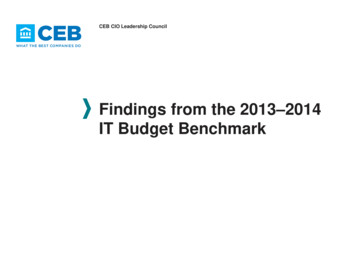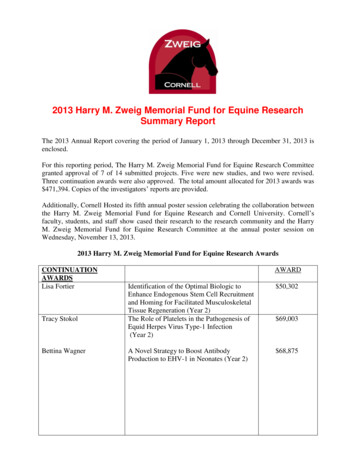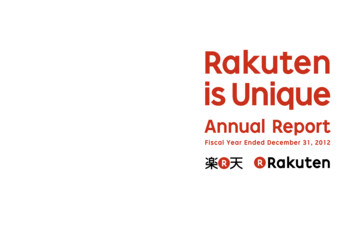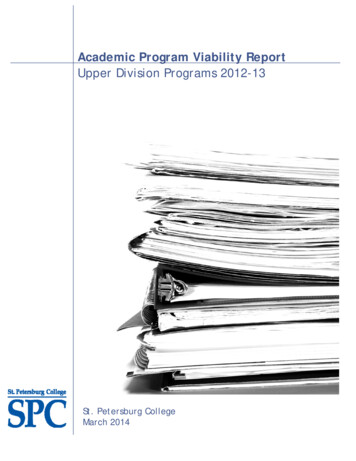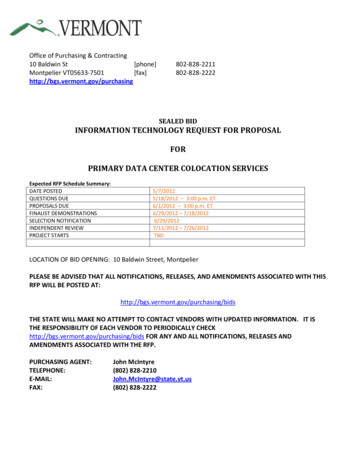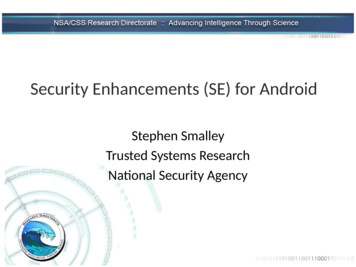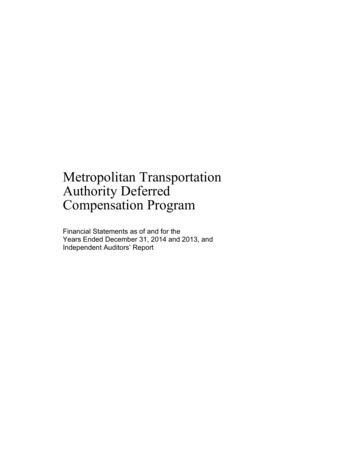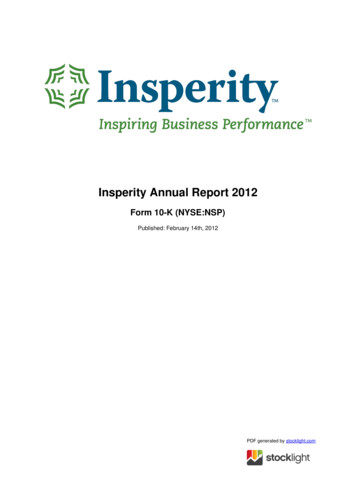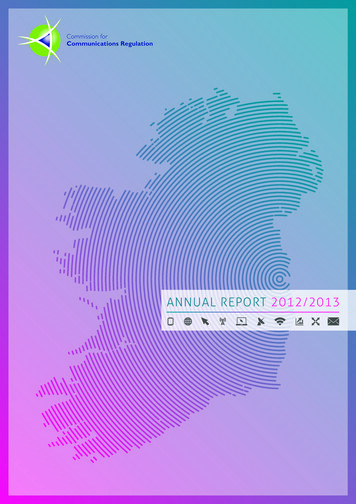
Transcription
Commission for Communications RegulationAnnual Report 20131ANNUAL REPORT 2012/2013
Safeguarding theConsumer InterestTo safeguard the interests of theconsumers of communicationservices by protecting andempowering themOur Mandate National & EuropeanLegislation National & InternationalCo-operation &Co-ordination activitiesOur MissionOur Values Integrity Impartiality Effectiveness Excellence TransparencyPromoting CompetitionHIGH LEVEL GOALSThrough effective and relevantregulation, our mission is tofacilitate the development ofa competitive communicationssector in Ireland that attractsinvestment, encouragesinnovation and empowersconsumers to choose and usecommunications services withconfidenceTo apply effective and proportionateregulation to facilitate dynamic andsustainable competitionFacilitating Innovation& InvestmentTo provide regulatory certainty thatfacilitates innovation and supportsinvestment in communicationinfrastructure and servicesStriving for OrganisationalExcellencePresented to the Minister forCommunications, Energy and NaturalResources in accordance with Section 32 ofthe Communications Regulation Act, 2002To be a highly effective andinnovative organisation which is acentre of excellence that supportsand enables its people to achievethe organization’s objectives
Commission for Communications RegulationAnnual Report 20133CONTENTS1. ABOUT COMREG4Commissioners5Executive Management Team5Chairperson’s Review of the period 2012/201382. COMMUNICATIONS MARKET OVERVIEW123. RETAIL AND CONSUMER SERVICES18Ensuring Consumer Welfare and Protection204. COMPETITION245. INNOVATION28Spectrum Management28Radio Spectrum Licensing31Numbering33Postal356. CORPORATE SERVICES DIVISION387. INTERNATIONAL AFFAIRS428. FINANCIAL STATEMENTS46
41. ABOUT COMREGComReg is the statutory bodyresponsible for the regulationof electronic communications(telecommunications, radiocommunications and broadcastingnetworks), postal and premiumrate services. ComReg is thenational regulatory authorityfor these sectors, in accordancewith EU and Irish Law. In additionwe manage the radio frequencyspectrum and the nationalnumbering resource, among otherresponsibilities.Organisational StructureThe Commission for Communications Regulation(ComReg) was established on 1 December 2002 andis led by a Commission of up to three Commissioners.At the end of this reporting period the Commissioncomprised solely of Commissioner Kevin O’Brien. AlexChisholm resigned in March 2013. Gerry Fahy andJeremy Godfrey were appointed as Commissioners inSeptember 2013.The Commission, with the Management PolicyCommittee (MPC), is responsible for the strategicand operational management of the organisation.ComReg depends on the efforts of all of ourstaff (including lawyers, economists, engineers,accountants, business analysts and administrativespecialists) to deliver on our mission and meet ourregulatory objectives.ComReg operates as a collegiate body, withdecisions taken collectively by the Commissioners.We see this as important in fulfilling the spirit ofthe Communications Regulation Act 2002, whichestablished the Commission. ComReg consists offour Divisions, supported by a General Counsel anda Senior Economic Advisor. The structure is basedon cross-functional teams operating in a multidisciplinary environment.
Commission for Communications RegulationAnnual Report 20135CommissionersKevin O’BrienGerry FahyJeremy e Management TeamCaroline Dee-BrownBarbara DelaneyJoe HeaveyGeneral CounselDirector, Retail and ConsumerDirectorServices DivisionCorporate Services DivisionDonal LeavyGeorge MerriganDirectorDirectorWholesale DivisionMarket Framework DivisionVacancyThe position of Senior Economic Advisor is currently vacant
6ComReg’s FunctionsThis Annual Report covers our key activities from1 July 2012 to 30 June 2013.ComReg is responsible for promoting competition,protecting consumers and for encouraging innovation.We deal in complex issues of law, economics,accounting, regulation and technology. We aim toensure that our decisions are explained clearly.Our objectives are set out in line with both primary andsecondary legislation, and this legislative frameworkcontinues to evolve. In 2007, ComReg’s responsibilitiesand powers, as well as available enforcementmeasures, were augmented by the CommunicationsRegulation (Amendment) Act 2007. In particular,ComReg was granted Competition Act powers inrelation to electronic communications and services. TheCommunications Regulation (Premium Rate Services& Electronic Communications Infrastructure) Act 2010transferred responsibility for the regulation of premiumrate services to ComReg and ComReg commencedregulation of this area in July 2010. Postal Regulation issubject to the 2011 Postal Act.Under the Communications Regulation Acts2002 to 2011, ComReg has a range of functionsand objectives in relation to the provision ofelectronic communications networks, electroniccommunications services and post. These include: Ensuring compliance by operators withobligations Promoting competition Contributing to the development of the internalmarket Promoting the interests of users within theEuropean Community Ensuring the efficient management and useof the radio frequency spectrum and numbersfrom the national numbering scheme Promoting the development of the postal sectorand, in particular, the availability of a universalservice Protecting the interests of end users ofpremium rate servicesKey contact details:The Commissioners’ OfficeCommissioner Gerry FahyCommissioner Jeremy GodfreyCommissioner Kevin O’Brien (Chairperson)Contact Marie CussenTel: 01 8049689Colette AndrewsTel: 01 8049644
Commission for Communications RegulationAnnual Report 20137The ComReg Divisions and theirDirectors:It is also responsible for ComReg’s interaction withMarket Framework - Director: George MerriganRetail and Consumer Services is responsible forMarket Framework is responsible for managingthe radio spectrum. It also oversees thegeneral authorisation regime for the electroniccommunications sector in Ireland and monitorscompliance with general authorisation conditions.Furthermore, it is responsible for the regulation ofthe Postal Sector. Market Framework manages radiospectrum and issues approximately 16,000 per year.Wireless Telegraphy licences to various companiesand individuals. In addition, Market Frameworkadministers Ireland’s National Numbering Plan, asEU institutions, including the Body of EuropeanRegulators of Electronic Communications (BEREC).the monitoring of the quality of service and pricecontrol of the Emergency Call Answering Service(ECAS). Since July 12 2010, this Division has beenresponsible for the regulation of premium rateservices.Contact: Michelle O’Donnell,Tel: 01 8049654Corporate Services Division - Director:Joe Heaveywell as providing the framework for new regulatoryThis Division develops and implements corporaterequirements for numbering for both fixed andaffairs and communications strategies designedwireless markets.to enhance organisational performance andeffectiveness. It is responsible for the humanContact: Sinéad Devey,resources, finance, information systems, freedom ofTel: 01 8049621information, public relations, and general facilitiesmanagement functions and strategic management forWholesale Division - Director: Donal Leavythe organisation.The Wholesale Division handles all issues concerningContact: Sharon Ward,the regulation of the wholesale telecommunicationsmarket including such matters as interconnection,dispute resolution, unbundling the local loop andthe pricing of regulated wholesale products. ThisTel: 01 8049720General Counsel: Caroline Dee-BrownDivision also has a role in relation to broadbandThe General Counsel advises on all majordeployment and next generation access. Wholesalelegal matters and on the legal implications ofhas responsibility for telecoms compliance. Thiscommunications policies in Ireland and the EU.Division also has responsibility for the regulatoryfinancial aspects of the telecoms sector.Contact: Colette Andrews,Tel: 01 8049644Contact: Claire Kelly,Tel: 01 8049710Retail and Consumer Services Division –Director: Barbara DelaneyThe Retail and Consumer Services Division handlesSenior Economic Advisor: VacancyThe Senior Economic Advisor is responsible forproviding economic advice to the Commission andeconomic input to key economic projects undertakenby ComReg.policy in relation to consumers’ interaction directlywith sellers of services. This includes areas such asContact: Colette Andrews,the universal service provision of telecoms access,Tel: 01 8049644consumer rights and some elements of retail pricingand roaming.
8CHAIRPERSON’S REVIEW OFTHE PERIOD 2012/2013One of the highlights of the year was the successfulconclusion of the multi-band spectrum auction inwhich four mobile network operators will pay a totalof 855m for rights of use across three spectrumbands through to 2030. A number of the mobilenetwork companies have started to roll out nextgeneration mobile services using this spectrum.Developments in the market show increasing evidenceof the positive impact of competition between marketplayers, due in part to appropriate regulation. Thetrend has been for market concentration levels, andprices both for wholesale and retail services, to fallwhile investment and quality levels have risen. Thistrend is evident across fixed and mobile markets,both for telephony and data services, but is especiallynoticeable in the enhanced value now on offer topurchasers of ‘bundled’ services offering somecombination of fixed and mobile telephony, broadbandand television services, and in the increasing rollout of fibre networks capable of handling high andThe Irish communications sectorhas continued to develop andimprove, but against the backdropof a severe recession. There wasa decline in total industry retailrevenues. At the end of June 2013total retail revenue stood at 3.18billion down from 3.31 billionover the previous 12 months.growing data usage.BroadbandAs of June 2013 there were over 1.6 millionsubscribers in Ireland, an increase of 0.7% on2012. According to Eurostat, Ireland’s householdpenetration for broadband reached 65%. Duringthe period under review there was strong growthin cable broadband take-up increasing by 13.1%.Average fixed broadband speeds also continued toincrease.At the end of June 2013, 37.5% of all subscriptionswere equal to or greater than 10 M/bits up from30.1% in Q2 2012. 29.9% of all fixed broadbandsubscriptions were equal to or greater than230 M/bits up from 19.6% in Q2 2012.
Commission for Communications RegulationAnnual Report 20139There were signs of progress over the year withstrong competitive pressure from operators and withCompetitionconsumers looking for greater value in both pricesThe period under review saw a number of veryand offerings. Increasing numbers of consumerssignificant developments with intensity inare getting greater value by choosing bundles ofcompetition increasing. The market share oftelephony, broadband and TV services.alternative operators continued to increase: therewas new entry into the fixed line market andMobile Marketsome consolidation among existing players. Theincumbent, Eircom, launched its new Next GenerationThe most significant development in the mobileAccess (NGA) services for both wholesale and retailmarket was the awarding, following an auction, ofcustomers.licences to provide next generation mobile services.At the end of June 2013 there were almost 5.67From a regulatory perspective ComReg made amillion subscriptions to mobile communicationsnumber of important decisions, including in relationservices in Ireland, which equals a penetration rateto Next Generation Access broadband and pricing ofof 123.3%. The level of text messaging declined byretail bundles.22.3% over the period due partly to the adoption byconsumers of instant messaging services. Averagemonthly voice call minutes per mobile subscriberin Ireland increased from 184 minutes per month inJune 2012 to 189 minutes per month in June 2013.This excludes usage of data services.In Q2 2013 average revenue per user wasapproximately 27 per month compared toapproximately 29 in Q2 2012. The decline in ARPUis due to a number of factors such as lower pricedmobile plans, an increase in bundles of communicationservices and reduced consumer spending. 416,011mobile numbers were ported between operators in theyear to June 2013, which means on average, 34,668mobile numbers were ported each month.Consumer ActivitiesThe provision of information and advice to consumersas well as the protection of their rights are keyparts of ComReg’s consumer mandate. By providingconsumers with information and knowledge aboutcommunications services and offerings, consumerswill make more informed choices and betterdecisions.ComReg also completed significant work in 2012 inrelation to the regulation of Premium Rate Services(PRS). In April ComReg launched a new Code ofPractice for Premium Rate Services which was tocome into full effect on 5 June. However a stay wasgranted by the High Court on 2 June in relation tocertain provisions, following application by some ofthe parties affected. This stay was then lifted by theHigh Court on 25 July, from which date the full codehas been in force, providing users of PRS servicesstrong regulatory protection. In 2012, ComReg hasalso made findings of non-compliance in relationto PRS and published them on its website www.phonesmart.ie.
10PostalComReg is accountable to the Oireachtas throughOireachtas Committees and appeared on threeDuring the year ComReg published its Postaloccasions during the period under review. On 7Strategy Statement which sets out proposed actions,November 2012 ComReg made a presentation to theand the timing of these, over a two year period.Joint Committee on Transport and CommunicationsComReg briefed the Joint Oireachtas Committee onin relation to its Postal Strategy Statement. On 17this Strategy Statement in November. During theJanuary 2013 ComReg appeared before the Publicperiod under review, ComReg established disputeAccounts Committee in relation to its Annual Report.procedures for postal service providers seekingOn 14 March 2013 ComReg appeared before the Jointaccess to the postal network of the universal postalTransport and Communications Committee in relationservice provider.to Wholesale Line Rental.International ActivitiesAs a public body operating in a difficult economicenvironment, an ongoing challenge is to continue toComReg continued to play an active role withinadd value while working within resource constraints.the Body of European Regulators of ElectronicIn the financial year to mid-2013, we continued toCommunications (BEREC) through direct participationreview and amend policies and procedures in relationin a number of workstreams and in leading the BERECto expenditure, procurement and risk management.work on measures to mitigate cross-border fraudor misuse of numbers. ComReg also participatedThe implementation of our procurement plan hasactively in the various international spectrum groupsalso been an important means of delivering on ourincluding RSPG and CEPT, and was part of Ireland’sobjectives. During the year we retendered for adelegation to the ITU World Radiocommunicationnumber of outsourced services to ensure value forConference 2012, at which a number of importantmoney.decisions were reached in relation to future useof spectrum for mobile and aeronautical services,among others.CorporateIn June 2012, ComReg issued its Strategy Statementfor the Electronic Communications sector 2012-2014.The Statement set out ComReg’s vision, goals andstrategies for the electronic communications sectorfor the two year period.We published our Annual Action plan at the start ofour Financial Year on 30 June which outlines specificwork-streams and other initiatives that ComRegundertakes in order to implement our strategy. Inconjunction with the Annual Action Plan, we alsopublished an Annual Output Statement which recordsand measures ComReg work achieved over the year.
Commission for Communications RegulationAnnual Report 201311
122. COMMUNICATIONSMARKET OVERVIEWNumber of operatorsBy the end of June 2013, WLR accounted for 66.7%Under the authorisations process,operators in Ireland notifyComReg of their intention toprovide networks or servicesto third parties. By June 2013,approximately 440 suchnotifications were registered byComReg. Of this, 367 were fixed/wireless authorisations, 10 weremobile telephony authorisationsand 63 were broadcastingauthorisations.68.6% at the end of June 2012), WLA accountedof lines provided via indirect access, (down fromfor 27.7% (up from 24.2% in June 2012) and CPSaccounted for 5.6% of lines (down from 7.2% in June2012). In total there were 509,541 indirect accesspaths at the end of Q2 2013, up by 5.8% since June2012.Figure 1: Narrowband Indirect Access Paths45.2% in June 2012, with Eircom making up the other51.9%.Fixed CPS, WLR and WLAIndirect access to fixed line networks for call servicescan be provided through Carrier Pre-Selection(CPS), where the call services are provided by anoperator using the incumbent operator’s network.The customer pays line rental to the incumbent.CPS, along with Wholesale Line Rental (WLR) anoperator can provide single billing to the consumerfor both their fixed line rental and fixed call usage.White Label Access-Voice Access (WLA-(Voice)) is aswitchless voice service which allows an operator topurchase end-to-end call services without the needto have its own interconnection 0,00043,519market in terms of revenue by June 2013 up from250,00046,134(OAOs) accounted for 48.1% of the total fixed line300,00048,911Report questionnaire, Other Authorised OperatorsAccess PathsBased on operator data submitted via the Fixed market share474,630550,000471,854600,000465,512Carrier Pre-Select, Wholesale Line Rental andWhite Label Access Paths Q2'11 - Q2'13Q1'12Q2'12Q3'12Q4'12Q1'13Q2'13WLASource: Quarterly Key Data Questionnaire
Commission for Communications RegulationAnnual Report 201313Fixed telecom access pathsAverage monthly voice call minutes per mobileThere were almost 1.64 million direct and indirectper month in June 2012 to 189 minutes perPSTN and ISDN access paths in the Irish market in Q2month in June 2013. This excludes usage of data2013, a decline of 8.2% since June 2012. Indirectservices. In Q2 2013 Average revenue per useraccess using WLR or CPS accounts for 31.1% of allwas approximately 26 per month compared toaccess paths in the fixed copper market.approximately 29 in Q2 2012 and 30 per monthsubscriber in Ireland increased from 184 minutesin Q2 2011. This decline in ARPU is likely to beSince ComReg reduced wholesale charges for Locala reflection of a number of factors such as thoseLoop Unbundling (LLU) there has been a markedattributable to economic conditions in Ireland (e.g.increase in take up of LLU lines, particularly sharedreduced consumer spending), and reductions inlines. This should help promote greater competitionmobile termination rates among other factors.in the retail market and lead to better offers forconsumers. There were 73,175 total LLU connections416,011 mobile numbers were ported betweenas of June 2013, up from 59,844 in June 2012.operators in the twelve months to June 2013, whichequates to, on average, 34,668 mobile numbersMobile telephonyported every month.At the end of June 2013 there were almost 5.67Although Vodafone and O2 retain the largest sharemillion subscriptions to mobile communicationsservices in Ireland, which translates to a penetrationrate of 123.3%of subscriptions (including mobile broadband)comparing Q2 2013 to Q2 2012, both Vodafone andO2 lost market share down to 39.9% and 26.8%from 41.2% and 28.5% respectively. Eircom GroupFigure 2: Mobile SubscriptionsMobile’s market share remained at 18.8% down fromMobile Subscriptions Q2'11 - Q2'1319.3% over the same period while 3 Ireland andTesco Mobile increased their market shares by 1.26,000,0005,473,7575,500,000and 0.3 percentage 15,024,636Data of additional operators included4,814,226Exclusion of M2M subscriptions4,500,000Subs excluding mobile broadbandand M2MSubs including mobile broadbandand M2MQ2 0Source: Quarterly Key Data QuestionnaireVolumes of text messaging decreased (down 22.3%)in June 2013 compared to June 2012. In the threemonths to June 2013, the average Irish mobilesubscriber sent an average of 170 messages permonth, compared with an average of 210 per monthin the quarter to June 2012.
14Figure 3: Market Share – Number ofSubscriptions (inc. mobile broadband and %30%20%subscriptions at 741,256. However, FWA and mobile1.9%3.4%1.8%3.3%41.2%40.9%40.7%Additional MVNOs mobileEircom Group MobileTesco MobileO2Q2'13VodafoneIn addition to broadband subscriptions, there are anestimated 2,655 WiFi hotspots in Ireland providing84.0% comparing Q2 2012 to Q2 %50%40%30%10%0%DSL 44.5%, FWA 3.8%, other 0.7% and mobilelaptop and smartphone users. This figure increased byDSL, Cable, Mobile and Other Broadband Subscriptions20%As of June 2013, cable subscriptions totalled 324,019.nomadic broadband access nationwide, particularly toFigure 4: Profile of Active BroadbandSubscriptions by Type60%subscriptions increased over the period.broadband 31.5% of all broadband subscriptions.Broadband90%2013. In contrast, DSL, cable and other (fibre/satellite)by the end of June 2013. In Q2 2013 cable was 19.5%,Source: Quarterly Key Data Questionnaire100%broadband subscriptions fell comparing Q2 2012 to Q2There were 524,039 mobile broadband subscriptions10%0%subscribers using broadband technologies. DigitalSubscriber Lines (DSL) still account for the bulk of theseMarket Share by Subscription (inc. HSDPA and M2M)Q2'12 - Q2'13100%By the end of June 2013 there were 1,665,231 internetOther (satellite/fibre)CableFWAMobile BroadbandSource: Quarterly Key Data QuestionnaireDSL
Commission for Communications RegulationAnnual Report 201315Figure 5: Broadband Subscriptions and ar-on-YearGrowthQ2’12-Q2’13By May 2013 of almost 1.59 million TV households in 1.4% 2.9%service, 39% had an aerial service, 38% had Irish DTT 1.7% 13.1%service and 14% had a free to air satellite service.-0.6%-2.9%Reception by other/local supplier (deflector/relay-2.8% 1.0%services), and IPTV methods is relatively low.1,141,192 1.3% 5.3%524,039-3.4%-8.1%1,665,231-0.2% eland, 71% had a subscription to cable or satelliteFigure 7: Television Homes by ReceptionMethodTV Homes by Reception Method, May 2011 - March 201390%Figure 6 illustrates Ireland’s position compared to80%other European countries for both mobile broadband70%50%behind the EU27 average (72%) for household69%38%38%71%71%68%38%39%35%40%broadband (fixed and mobile) penetration in 2012.30%20%Figure 6: European household broadbandpenetration comparison, 0%AerialUK Freeview DTTIPTVCable/Satellite(exc. other satellite)Other satelliteIrish 12Jan-12Nov-11Sep-110%Housebold Broadband Penetration, 2012Source: Nielsen TV Audience Measurement Establishment Survey on Behalf of TAM Ireland 60%household penetration in 2012. Ireland (65%) was10%69%Source: Eurostat, Statistics in Focus 50/20121As of Q2 2013 DSL lines also includes Very-high-bit-ratedigital subscriber lines (VDSL).2Other Broadband includes Satellite and Optical Fibrebroadband subscriptions.
16PricingComReg also collects comparative data on a numberIreland’s PSTN residential basket, as measured bymedium and high-usage post-paid subscriptions asan OECD-approved methodology, was behind thewell as price for a pre-paid subscription. As of MayEuropean benchmarked average. The Irish package2013, for the medium-user post-paid basket, Irelandused for this comparison was 14% more expensiveis five places ahead of and 17.0% cheaper thanthan the average for the other European countriesthe benchmarked average. For the pre-paid basket,charted in May 2013. However, the PSTN businessIreland is four places behind the average of thebasket for Ireland was 28% cheaper than thecountries benchmarked.of mobile baskets, which estimate a price for low,benchmarked average.Figure 10: OECD post-paid mobile basketFigure 8: OECD PSTN Residential BasketOECD Medium User Post Paid Basket - May 2013OECD Residential Basket - May 201350804540703560Euro/ PPP1550401051530O2 Choices 400, SIM only, 1 month25102015305FixedF2FF2MVoiceHungary (20)Italy (19)Portugal (16)Spain (18)Greece (14)Germany (17)Czech Rep. (21)AverageSlovak Rep. (15)Slovenia (13)Netherlands (7)Luxembourg (11)Ireland (10)Belgium (12)Poland (8)Sweden (9)UK (5)MessageFinland (6)Finland (21)Italy (17)Portugal (20)Spain (18)Czech Rep. (19)Ireland (16)France (14)Austria (15)AverageGermany (12)Belgium (11)Slovak Rep. (10)UK (5)Greece (9)Netherlands (8)Slovenia (6)Luxembourg (7)Estonia (13)Sweden (3)Denmark (4)Poland (1)Hungary (2)0Estonia (3)0France (1)510Denmark (4)1020Austria (2)Euro PPP per monthEircom Talk Anytime, Mobile Light 60FixedSource: Teligen - Note: Medium user 100 calls/monthPrevious rankings for February 2013 in bracketsIntnSource: Teligen - Previous ranking for February 2013 in bracketsFigure 11: OECD pre-paid mobile basketFigure 9: OECD PSTN Business BasketOECD Pre Paid Basket - May 2013OECD Residential Basket - May 2013Speak Easy - o2 Experience Plus ,EUR 20 Top-upEuro / PPP1201580Eircom Value Business Plan6025201510510540F2FF2MVoiceFixedSource: Teligen - Note: 40 calls/monthPrevious rankings for February 2013 in bracketsHungary (21)France (19)Netherlands (20)Portugal (16)Czech Rep. (18)Ireland (17)Slovenia (15)Slovak Rep. (13)Belgium (12)AverageUK (9)Spain (14)Italy (11)Germany (10)Poland (7)Finland (3)Sweden (5)Austria (8)Estonia (2)Greece (4)MessageLuxembourg (6)Czech Rep. (21)Italy (20)Finland (19)Portugal (18)Denmark (14)IntmSource: Teligen - Previous ranking for February 2013 in bracketsSlovak Rep. (17)Spain (15)Hungary (16)Estonia (13)AverageBelgium (11)Netherlands (12)Sweden (10)Austria (9)Greece (8)France (7)Poland (5)Ireland (6)Slovenia (3)FixedGermany (2)UK (1)0Denmark (1)020Luxembourg (4)Euro PPP per month10030
Commission for Communications RegulationAnnual Report 201317In overall terms, figure 12 shows the change in theConsumer Price Index (CPI) and the communicationssub-component. The CSO weights communications as3.133% of the total CPI.Total CPI increased by 0.7% in the year to June 2013while communications costs decreased by 2.4%.Figure 12: Central Statistics Office ConsumerPrice IndexConsumer Price Index and Communications Sub-component,December 2011 100103102101Communication10099All Items98979695Source: Central Statistics M102011M092011M082011M072011M0694
183. RETAIL AND CONSUMERSERVICESComReg’s overall goal in relationto consumer protection is toinform, empower and protectconsumers, residential andbusiness, and to ensure theavailability of a universaltelecommunications service.Progress in relation to these varied aspects of the roleis outlined below as follows: Informing, empowering and protectingconsumers Ensuring consumer welfare and protection Ensuring availability of a universaltelecommunications service.Informing, Empowering andProtecting ConsumersComReg seeks to empower consumers throughoffering an effective complaints handling processwhile also ensuring the availability of appropriateand transparent information. ComReg seeks toidentify the needs of consumer segments suchas businesses, individual consumers, people withdisabilities and vulnerable consumers in respectof electronic communications. ComReg monitorsdevelopments by liaising with various stakeholdersusing a variety of mechanisms such as our ConsumerLine; our websites; our Consumer Outreachprogramme; the ComReg Consumer Advisory Panel;the Forum on Electronic Communications Services forPeople with Disabilities; relevant surveys and inputsfrom consumer organisations with which we liaiseclosely.Consumer WebsitesComReg also continues to ensure that consumers areaware of relevant new developments and servicesby enhancing the independent information on ourwebsites: www.askcomreg.ie provides generalinformation for consumers in respect ofelectronic communications and postal services. www.callcosts.ie is ComReg’s price comparisonwebsite for consumers. www.phonesmart.ie, the premium rate servicewebsite has a convenient facility to check thename and contact details for the premium rateservice provider based on a five digit number.These websites had 363,427 visits re
control of the Emergency Call Answering Service (ECAS). Since July 12 2010, this Division has been responsible for the regulation of premium rate services. Contact: Michelle O'Donnell, Tel: 01 8049654 Corporate Services Division - Director: Joe Heavey This Division develops and implements corporate affairs and communications strategies designed
